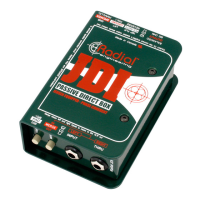Part 5 – Features and Functions
The ¼” INPUT and THRU connectors
The JDI features two ¼” jacks on the input panel. These are designed to
accept instrument inputs from basses, guitars, keyboards, drum machines,
etc. The left ¼” input jack is normally connected to the source instrument.
The right ¼” jack is normally used as a parallel ‘thru’ connector and feeds
the instrument signal to the musician's on-stage amplier.
Using the 'thru' jack with an on-stage amplier allows both the musician
and the engineer to work with the original signal direct from the instrument
(Fig. A). This way, the musician can set up his stage sound with his own
EQ while the audio engineer can process the instrument to sound good
in the venue through the PA system.
Some instruments do not use on-stage amplication. It is common for
instruments such as acoustic guitar to be connected directly to the PA
system through the JDI using only the balanced XLR output (Fig. B). This
allows the signal to feed the stage snakes, monitor mixer for foldback
and main PA, just like microphone signals do. In this case, the thru jack
would not be used.
The MERGE switch
The JDI features an innovative ‘merge’ function that turns the input and
the thru-put into a ‘left-right to mono’ mix. Depressing the merge switch
introduces a resistive mixer circuit that sums the two channels at the XLR
output. This function allows two sources such as a stereo keyboard or
CD player to merge to ‘mono’, saving valuable channels on the snake and
the mixer when you have more sources than available inputs.
To ‘merge’ simply connect two instruments with similar output levels into
the IN and THRU jacks, depress the MERGE switch to the ON position
and you are set to go. The internal resistive mixer is set up to do this
without introducing any problems such as phase cancellation.
JDI
Input
Thru to
Amp
Balanced XLR
out to mixer
JDI
Input
Balanced XLR
out to mixer
Fig. A: JDI used with on-stage instrument amplier.
Fig. B: JDI used with acoustic instrument direct
to audio system.
True to the Music
Radial Engineering JDI
™
User Guide
7

